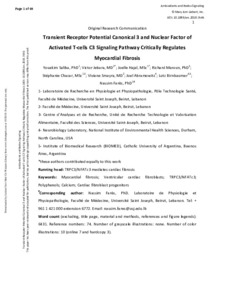Please use this identifier to cite or link to this item:
https://repositorio.uca.edu.ar/handle/123456789/9853| Título: | Transient Receptor Potential Canonical 3 and nuclear factor of activated T cells C3 signaling pathway critically regulates myocardial fibrosis | Autor: | Saliba, Youakim Jebara, Victor Hajal, Joelle Maroun, Richard Chacar, Stéphanie Smayra, Viviane Abramowitz, Joel Birnbaumer, Lutz Farès, Nassim |
Palabras clave: | TRPC3; CALCIO; FIBROSIS; POLIFENOLES; CARDIOPATIAS; TRATAMIENTO MEDICO | Fecha de publicación: | 2019 | Editorial: | Mary Ann Liebert | Cita: | Saliba, Y. et al. Transient Receptor Potential Canonical 3 and nuclear factor of activated T cells C3 signaling pathway critically regulates myocardial fibrosis [en línea]. Antioxidants & Redox Signaling. 2019, 30(16). doi:10.1089/ars.2018.7545 Disponible en: https://repositorio.uca.edu.ar/handle/123456789/9853 | Resumen: | Abstract: Aims: Cardiac fibroblasts (CFs) are emerging as major contributors to myocardial fibrosis (MF), a final common pathway of many etiologies of heart disease. Here, we studied the functional relevance of transient receptor potential canonical 3 (TRPC3) channels and nuclear factor of activated T cells c3 (NFATc3) signaling in rodent and human ventricular CFs, and whether their modulation would limit MF. Results: A positive feedback loop between TRPC3 and NFATc3 drove a rat ventricular CF fibrotic phenotype. In these cells, polyphenols (extract of grape pomace polyphenol [P.E.]) decreased basal and angiotensin II-mediated Ca2+ entries through a direct modulation of TRPC3 channels and subsequently NFATc3 signaling, abrogating myofibroblast differentiation, fibrosis and inflammation, as well as an oxidative stress-associated phenotype. N(ω)-nitro-l-arginine methyl ester (l-NAME) hypertensive rats developed coronary perivascular, sub-epicardial, and interstitial fibrosis with induction of embryonic epicardial progenitor transcription factors in activated CFs. P.E. treatment reduced ventricular CF activation by modulating the TRPC3-NFATc3 pathway, and it ameliorated echocardiographic parameters, cardiac stress markers, and MF in l-NAME hypertensive rats independently of blood pressure regulation. Further, genetic deletion (TRPC3−/−) and pharmacological channel blockade with N-[4-[3,5-Bis(trifluoromethyl)-1H-pyrazol-1-yl]phenyl]-4-methyl-benzenesulfonamide (Pyr10) blunted ventricular CF activation and MF in l-NAME hypertensive mice. Finally, TRPC3 was present in human ventricular CFs and upregulated in MF, whereas pharmacological modulation of TRPC3-NFATc3 decreased proliferation and collagen secretion. Innovation and Conclusion: We demonstrate that TRPC3-NFATc3 signaling is modulated by P.E. and critically regulates ventricular CF phenotype and MF. These findings strongly argue for P.E., through TRPC3 targeting, as potential and interesting therapeutics for MF management. | URI: | https://repositorio.uca.edu.ar/handle/123456789/9853 | ISSN: | 1523-0864 (impreso) 1557-7716 (online) |
Disciplina: | MEDICINA | DOI: | 10.1089/ars.2018.7545 | Derechos: | Acceso abierto | Fuente: | Antioxidants & Redox Signaling. 2019, 30(16) |
| Appears in Collections: | Artículos |
Files in This Item:
| File | Description | Size | Format | |
|---|---|---|---|---|
| transient-receptor-potential-birnbaumer.pdf | 5,81 MB | Adobe PDF |  View/Open |
Page view(s)
259
checked on Dec 5, 2025
Download(s)
186
checked on Dec 5, 2025
Google ScholarTM
Check
Altmetric
Altmetric
This item is licensed under a Creative Commons License

